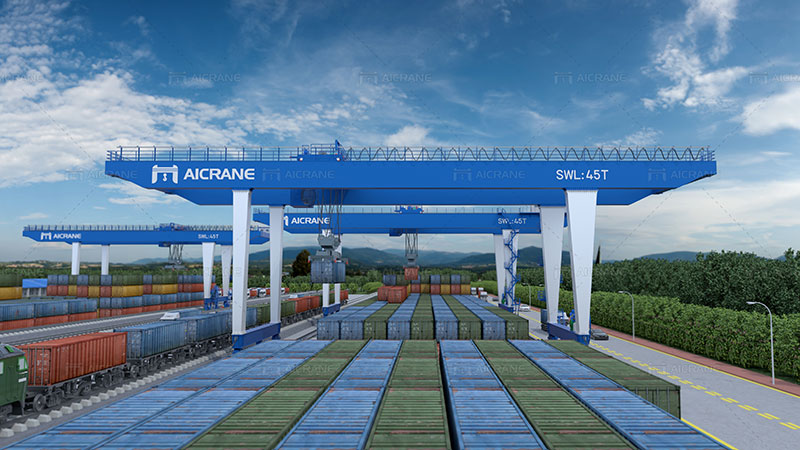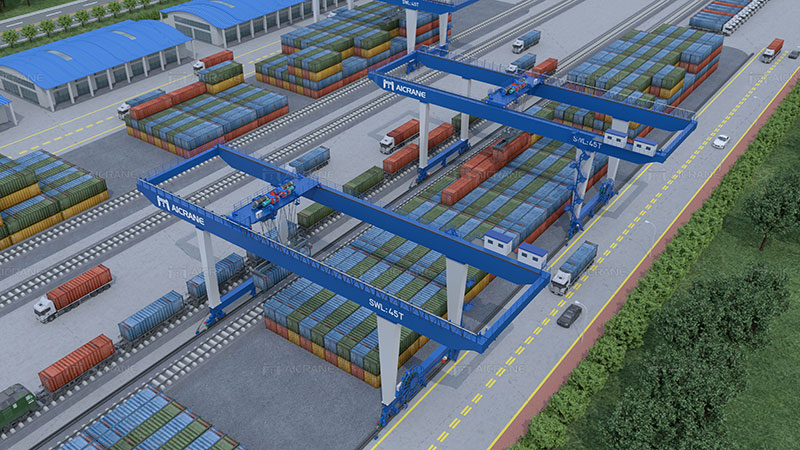In the world of modern logistics and industrial operations, efficiency, precision, and safety are paramount. To meet these demands, industries have turned to innovative solutions, and one such game-changer is the Rail Mounted Gantry (RMG) crane. RMG cranes have transformed the way materials are handled and stored, providing a versatile and efficient solution for various sectors, including shipping, warehousing, and manufacturing. In this article, we explore the many uses and advantages of RMG cranes, demonstrating how they have become indispensable in contemporary material handling operations.
What is an RMG Crane?
A Rail Mounted Gantry crane, commonly known as an RMG crane, is a specialized material handling machine designed to move and stack containers, heavy goods, or other loads in a precise and efficient manner. These cranes are typically utilized in container terminals, intermodal yards, and warehouses, where high-capacity and automated handling of containers and other cargo are required. An RMG crane operates on rails, which allows it to traverse along a predetermined path, providing exceptional accuracy and control.

The Use of RMG Cranes
Container Handling in Ports
One of the most common and critical applications of RMG cranes is in container handling at ports and container terminals. These cranes play an essential role in the loading and unloading of shipping containers from vessels, as well as the efficient movement and stacking of containers within the terminal yard. The ability of RMG cranes to reach several containers in height and span multiple container rows is crucial for optimizing space and streamlining the handling process.
The advantages of using RMG cranes in port operations are numerous. They can handle a vast number of containers quickly and with precision, reducing the turnaround time of vessels. This increased efficiency leads to reduced labor costs and, in turn, lower shipping expenses. Additionally, RMG cranes are less dependent on human labor, which enhances safety in a challenging and often hazardous port environment.
Intermodal Terminals
Intermodal facilities, which serve as the crossroads of different modes of transportation (e.g., rail, truck, and ship), rely on RMG cranes to efficiently transfer containers between various transport vehicles. RMG cranes can move containers from trucks or trains onto the ground or directly onto other forms of transportation, such as ships or railcars. Their precision and high lifting capacity are vital for the seamless transfer of containers, reducing transit time and increasing the overall efficiency of the intermodal terminal.
Container Depots and Logistics Centers
Container depots and logistics centers frequently use RMG cranes for the stacking, sorting, and repositioning of containers. RMG cranes can operate within the confined spaces of depots, making them well-suited for organizing and maintaining containers in these facilities. This versatility is essential for managing container inventories efficiently and ensuring quick access to needed cargo.
Automated Warehouses
Beyond container handling, RMG cranes have found applications in automated warehouses. These container handling gantry cranes are used for the efficient storage and retrieval of palletized goods or containers within high-bay storage systems. They operate on fixed rails, traveling between storage bays to locate, pick, and deposit items. The automation and precision of RMG cranes make them suitable for high-density storage and retrieval operations, ensuring goods are readily available when needed.
Manufacturing Facilities
RMG cranes are also making their mark in manufacturing environments. These cranes are utilized to transport heavy materials, machinery components, and products within large production facilities. They help streamline production processes, enhance material handling efficiency, and reduce the need for manual labor, which can be both costly and physically demanding.

High-Rise Construction Sites
In high-rise construction, RMG cranes are employed to transport construction materials, such as steel beams, concrete blocks, and scaffolding, to various levels of the building under construction. They are well-suited for this task due to their capacity to lift heavy loads to great heights with precision. RMG cranes in construction sites improve safety, reduce the need for manual labor at heights, and expedite construction progress.
Advantages of RMG Cranes
Precise and Automated Operations
RMG cranes are renowned for their precision in material handling. They can lift, transport, and stack containers or goods with exceptional accuracy, reducing the risk of damage and errors in cargo handling. The automation of these cranes further enhances their precision, ensuring that operations are consistent and reliable.
High Lifting Capacity
RMG cranes are designed to handle heavy loads. Their lifting capacity can vary, but they are often capable of lifting containers weighing several tons. This high lifting capacity is crucial for the efficient handling of cargo in industrial settings.
Reduced Labor Dependency
RMG cranes significantly reduce the need for manual labor in material handling. This not only decreases labor costs but also improves safety in environments where heavy loads are handled, such as ports and construction sites.
Space Optimization
RMG cranes can stack containers and goods with great efficiency, making the most of available space. This is especially important in container terminals, warehouses, and intermodal yards, where space utilization directly affects operational efficiency and profitability.
Cost Efficiency
The use of RMG cranes typically results in cost savings in the long run. Their ability to handle materials quickly and accurately reduces operational costs, improves productivity, and minimizes the risk of accidents, leading to financial benefits for businesses.
Enhanced Safety
Safety is a top priority in industries that rely on heavy material handling. RMG cranes contribute to a safer working environment by minimizing the need for manual labor, reducing the risk of injuries, and improving the accuracy and control of cargo handling.
Environmental Considerations
Some RMG cranes are designed with environmental considerations in mind. They may incorporate energy-efficient technologies, such as regenerative braking and reduced emissions, to lower their environmental impact.
Conclusion
Rail Mounted Gantry (RMG) cranes have proven to be invaluable assets in a variety of industries, from shipping and logistics to manufacturing and construction. Their precision, high lifting capacity, reduced labor dependency, space optimization, cost efficiency, and enhanced safety make them essential tools for modern material handling. Whether in ports, intermodal terminals, warehouses, or manufacturing facilities, RMG cranes play a pivotal role in ensuring the efficient and reliable movement of goods and cargo, contributing to the success and competitiveness of businesses across various sectors. As technology continues to advance, the role of RMG cranes is expected to evolve and expand further, solidifying their place as indispensable assets in the world of material handling and logistics. For more info, visit our website: https://steelmillcranes.com/